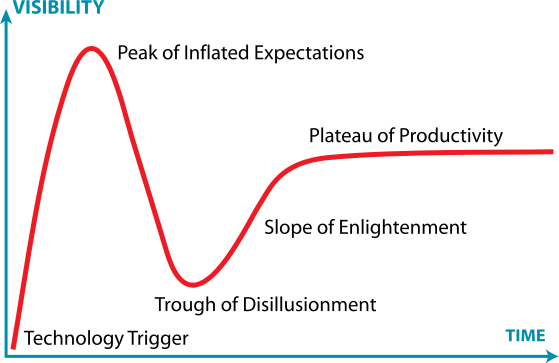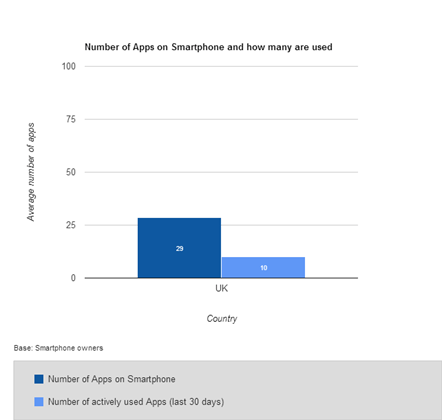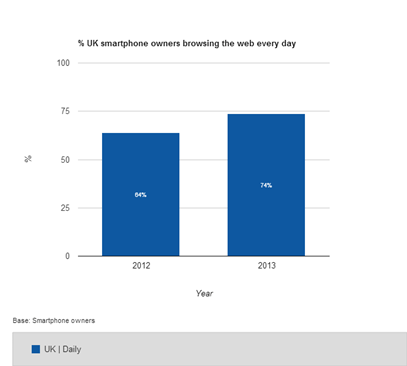As technologists we are often guilty more than most of using and latching onto ‘buzzwords’. On a constant mission to differentiate ourselves from our competitors we seek the ‘unique value proposition’. We ‘think outside the box’; our internal teams have ‘mind showers’ where ‘blue sky thinking’ shortlists possible ideas that we may ‘focus group’. We may take one of these ideas and ‘run it up the flagpole to see who salutes it’.
Of course, this is all nonsense, and I will stop now!
In recent years the choice and availability of recruitment software has proliferated. With so much choice and vendor ‘hype’ it becomes difficult for potential clients to understand what on earth the solution provider is talking about. They are using their language, not yours. They are providing their ‘solution’ without understanding your problems, your issues and your goals.
Almost ten years ago the Gartner Group defined the technology ‘Hype Cycle’. It’s interesting on a number of levels (not least of which is that it isn’t actually a cycle!). The hype cycle is a simple chart that positions specific technologies based on their time within the social conscience and the level of visibility (or perhaps ‘noise’ would be a better noun) they have generated.

(Gartner Research’s Hype Cycle)
The cycle works like this. There is a technology trigger, somebody makes a breakthrough, the media pick up on it, early proof of concepts seem to be good, the hype begins, there are a few early adopters, the new technology is predicted to be a ‘game changer’ (sorry!) ….the noise gets louder and we reach a ‘peak of expectation’.
Then reality bites, the new technology has faults and feature gaps, at this point it is vital that the technology provider listens to customer feedback to further develop their solutions not just based on what they ‘can do’ but what they ‘should do’, after all the value of software is the value of the problem it solves for each customer uniquely.
Those technology companies who don’t listen to their customers will eventually disappear, either fizzling out through lack of ‘traction’ (in other words they haven’t sold to enough customers to make a viable business that can support their customers and develop their product) or be bought out by a larger company who wants a piece of this new market.
The smart companies though will adapt to the new reality, constantly learning from their customers and developing their solutions based on the customer’s needs, These technologies are then seen to be on the ‘slope of enlightenment, moving beyond the early adopters until the technology becomes ubiquitous. By this point there is only so much incremental value that can be added by the technology provider, and the brave new technology that was once seen as a ‘game changer’ has become just a taken for granted checkbox in a Request for Proposal…you just expect your recruitment software to provide it.
So, where in the Hype Cycle do specific recruitment software technologies currently sit? Let’s look at Mobile Recruiting as an example. The release of the Apple App Store in 2008 was the technology trigger that fuelled an immense amount of hype. ‘We need an app!’ became the battle cry in boardrooms across the country,

(thinkwithgoogle.com/mobileplanet)
According to Google’s ‘Our Mobile Planet’ tool (thinkwithgoogle.com/mobileplanet) the average UK smartphone user has download 29 apps to their phone. However they only actively use 10 of them. So the chances are a) your app won’t actually get downloaded and b) even if it is downloaded it has some pretty stiff competition from the likes of Candy Crush and Angry Birds. Are native recruitment apps then in the ‘trough of disillusionment?’

(thinkwithgoogle.com/mobileplanet)
Meanwhile mobile web browsing has increased dramatically, as smartphones have improved and companies have implemented ‘responsive Web Design’ to ensure that their website adapts automatically to the capabilities of the device the user is viewing with. In the UK 74% of mobile users use their device every day for browsing the web (source: thinkwithgoogle.com/mobile planet), I’d say that places web-based responsive career sites well on the slope of enlightenment.
So, next time a would be software provider starts talking in buzzwords (things to look out for ‘talent communities’, ‘recruitment 2.0’ etc.) ask about adoption rates by their clients and what real-world value they have delivered, that way you’ll know whether it’s just ‘inflated expectation’ and you’ll differentiate the hype from the reality.